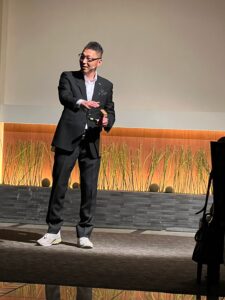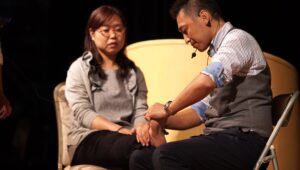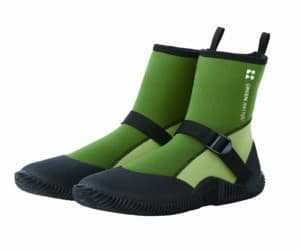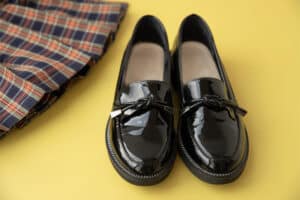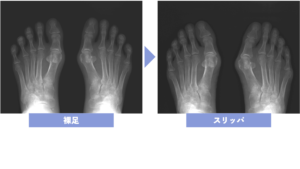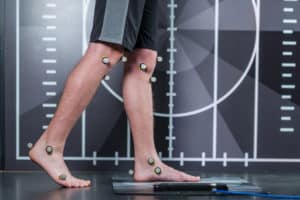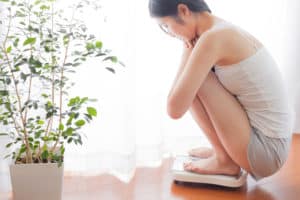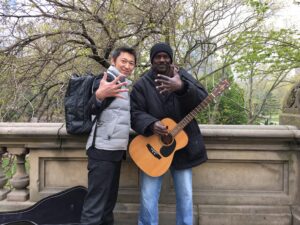第7話|足裏の筋肉を鍛えるには、小股で歩こう
骨格差に合った歩き方
正しい靴を選び、履き方を覚えたら、次は歩き方です。
Aさんは変形性膝関節症で軟骨が磨り減り、正座も階段昇降もできないTさんは、人工関節手術をしようか悩んでいました。来院時に歩き方を見ると、これがドスン、ドスンと大きな音のする大股歩き。そこでかかとが着く際の音が立たないよう、小股での歩き方を指導したところ、2ヶ月後、「階段も上がれるし、正座もできますよ」と喜びの報告がありました。

この事例の根っこには、日本人と西洋人の骨格の差があります。両者の重心の違いが歩き方に関係するからです。背中を丸めて前かがみになった田植えの時の姿勢に象徴される「骨盤前傾」の日本人は、骨盤が後ろに傾きがち。だから小股で歩くのが適します。一方、馬などに農具を引かせ、直立の姿勢で農耕をする「骨盤後傾」の西洋人の骨格は、骨盤が前に傾きがち。大股でかかと着地が向いているのです。

長年染み込んだ前方重心のDNAはそんなに早く変われないのですが、文明開化によって日本人が西洋靴を履くようになり、大股でかかとから着地する西洋型歩行になりました。今ではそれが正しい歩き方となっていますが、はたして日本人に合った歩き方といえるでしょうか。体を美しく見せるモデル歩きや、ヒールを履いて歩くときとは分ける必要があります。オシャレと健康は別なのです。
小股で足裏全体を使って
わらじでかかとを着けない歩き方は足指を使います。一方、大股のかかと着地は足指を使いません。そのため、脚のゆがみも大きくなりがちです。靴底の外側が減っていたら、その傾向があると思ってください。仕事上、そう言った歩き方をしないといけない場合、1日の最後に歯磨きの感覚で小股歩きをしてください。
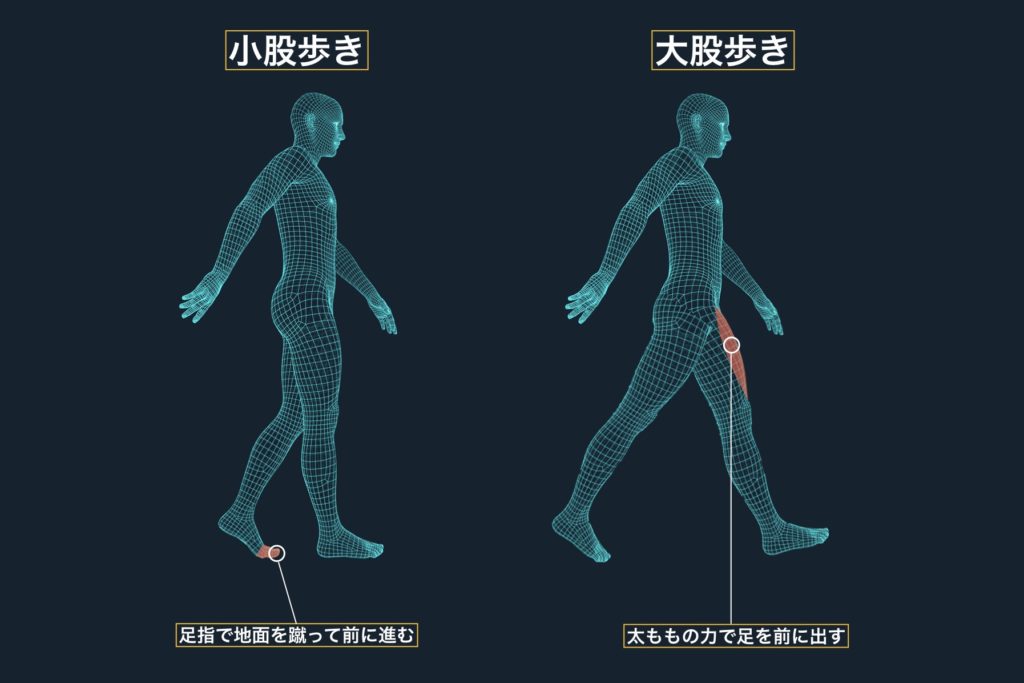
小股歩きの癖をつけるには、まず後ろ向きに歩いてみること。自然と歩幅が小さくなり、足指を使って床を蹴って歩く感覚がつかめたら、そのままの歩幅と速さで前向きに歩きます。それが小股歩きを体に覚えさせる秘訣です。
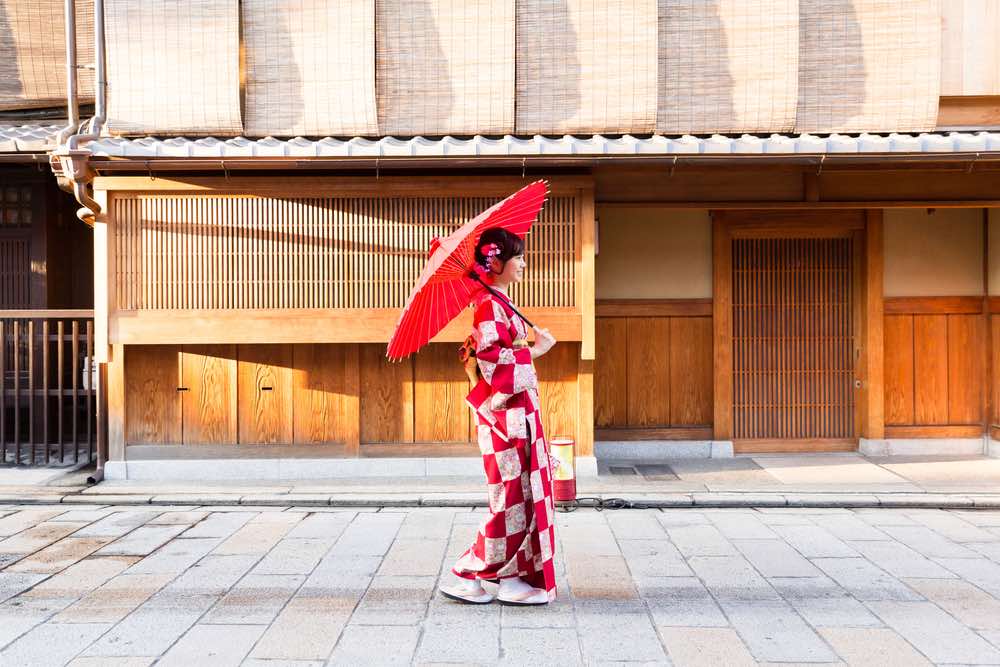
着物を着て、膝下を使って歩くような感覚といえば分かるでしょうか。もしくは家の中でフローリングの音がしないように歩いてみてください。自然と小またで足裏全体を使った歩き方になるはずです。その歩き方を毎日5分続けると、自然と足裏の筋肉がつき、歩くバランスが改善。健康ですてきな歩き方になりますよ。
人の体は足指を使って歩くことで全身の正しい筋肉を使う(前後左右に均等に筋肉を使う)ことができますが、靴や靴下、歩き方などによってその機能が発揮できにくくなっています。これまで歩くことで膝・腰を悪くしてきた方もいらっしゃると思いますが、それは足指を曲げて歩いていたからです。足指を広げて歩けば歩くことで体のゆがみが良くなるということを、実感していただければと思います。次回は足指に良い靴下についてお話をしていきます。
はだし文化の国では小股歩き
大股歩きが広まったのは、30年ほど前のジョギングブーム。ジョギングで突然死する人が増えて社会問題にもなりましたが、運動をまったくしないのも健康によくない。そこで、「ウォーキング」というブームが生まれたのです。

ジョギングの神様・ジェイムズ・フィックスはジョギングが原因で死んだ!?
そのとき「正しい歩き方」とされたのが、広い歩幅で腕を振って歩くこと。着地するときはかかとから、そして、つま先で蹴り上げて前に進むことが推奨され、以降、「大股で歩くことが正しい」とされてしまいました。ウォーキングの本にも、「できるだけ大股で歩きましょう」なんて書いてあります。これは日本だけではなく、世界中に広まっています。しかし、大股で歩くことにまったく意味はなく、ダイエットには向いているかもしれませんが、人生100年、自分の足で歩くカラダを作るには不向きです。
「立つ」「歩く」「坐る」といった日常の動作に必要なのは、足裏の筋肉です。つまり、中高年の方の場合、大きな筋肉ではなく、足裏にある筋肉を主に鍛えたほうがいい。それが、死ぬまで自分の足で歩き、健康寿命を延ばすことにつながります。ところが大股歩きでは、(ももの裏側にある)ハムストリングスや大腿四頭筋(ふともも)など速筋を中心とした筋肉が使われる。速筋は疲れやすく、肉離れを起こしやすいのです。肉離れを起こしたら、なんのために運動を始めたのかわからなくなります。
ひろのば体操
足指を広げて(=ひろ)伸ばす(=のば)、足指と足のストレッチのこと。左右の足を合わせて1日1回、5分もやれば効果があります。
YOSHIRO SOCKS
足指専門の理学療法士として積み上げてきた20年間の知識や経験を生かし、足指を広げて伸ばす靴下を開発。人間本来の姿勢や運動能力に戻します。
◎ Walk in the way that is appropriate to your bone structure.
After leaning the right way of choosing shoes, wearing them, now it’s the way of walking.
Ms. T had knee osteoarthritis that the cartridge in her knee was worn out. She was unable to go up or down the stairs and was debating whether to have a surgery. When she came walking into my office, her steps were big and I could hear her stomping. I advised her to start walking in small steps; so small that you can’t hear your heels landing on the ground. Then 3 months later she reported to me with joy that now she was able to go up and down the stairs.
In the foundation of this case lies a difference of the bone structures between Japanese and Westerners. The difference in the way of holding the body balance is the key to this.
We Japanese balance ourselves slouching frontward as symbolized in the posture of bending over in rice fields in old days. In that posture the pelvis tends to lean backwards, therefore it is better to walk in small steps. On the other hand, the westerners balance on their heels as they farmed sitting or standing upward using horses and equipment. Therefore, their pelvis leans forwards, hence the style of walking in big steps and landing on their heels works for them.
It’s hard to change the DNA’s of leaning backwards from a long time ago, but we have shifted to wearing western style shoes, walking in big steps, and landing on heels. Nowadays it’s been said that’s the right way of walking, but is that really so for us Japanese? We need to separate the way of walking like a fashion model to show the beauty of the body walking in heels from the way of walking on a daily baisis. Fashion and health are two different things.
◎ Use the overall back of foot and walk in small steps
Wearing waraji, straw sandals, which the Japanese wore in old days, makes you use your toes, as you can’t quite land on heels. On the other hand walking in big steps and landing on heels does not. As a result greater deformities of foot could occur. If you see your shoe sole worn down on the outer, you are walking in big steps landing on heels. If you are required to walk that way due to your work, try and walk in small steps at the end of the day when you go home, just like you brush your teeth at the end of the day.
In order to make it a habit to walk in small steps, first try and walk backwards. Naturally your steps will be smaller and you will feel that you are kicking the floor using your toes. Then walk in reverse, going forwards. That is the key to have your body get used to walking in small steps.
It’s similar to walking in kimono’s, so to speak, or walking on a wooden floor trying not to make any sound. This should naturally bring you to walk in small steps using the overall back of your foot.
Continuing walking that way for 5 minutes everyday will improve in maintaining the balance of your body as it helps building your muscles on the back of your feet. You’ll be healthy and walking beautifully.
X X X
The human body uses the appropriate muscles of the overall body by walking using the toes. However, wearing socks and shoes have made it challenging for the toes to be as functional as they should be. I’m sure there are people who have had pain in their back and knees from walking, but that’s because they have been walking with their toes crooked. I would like them to experience themselves that stretching their toes and walking using their toes will correct the distortion of their overall bone structures.


